文章信息
- 赵万伏, 宋垠先, 管冬兴, 马强, 郭超, 文宇博, 季峻峰
- ZHAO Wan-fu, SONG Yin-xian, GUAN Dong-xing, MA Qiang, GUO Chao, WEN Yu-bo, JI Jun-feng
- 典型黑色岩系分布区土壤重金属污染与生物有效性研究
- Pollution status and bioavailability of heavy metals in soils of a typical black shale area
- 农业环境科学学报, 2018, 37(7): 1332-1341
- Journal of Agro-Environment Science, 2018, 37(7): 1332-1341
- http://dx.doi.org/10.11654/jaes.2018-0595
文章历史
- 收稿日期: 2018-05-07
- 录用日期: 2018-05-23
2. 宁夏回族自治区国土资源调查监测院, 银川 750002;
3. 河海大学环境学院, 南京 210098
2. Ningxia Institute of Land Resources Survey and Monitor, Yinchuan 750002, China;
3. College of Environment, Hohai University, Nanjing 210098, China
土壤重金属污染所带来的环境问题日益严重, 已受到普遍关注[1]。人为活动和自然来源是土壤重金属的两大来源[2-3], 自然来源主要是指在成土过程中母质所含的重金属经风化、淋溶等作用, 在土壤中富集从而形成地质高背景值。近年来, 通过相关调查、分析发现, 发育于黑色页岩区域的土壤存在不同程度的重金属污染[4-8]。黑色页岩形成于停滞还原的水环境中, 具有特殊活性, 由于在沉积过程中富含硫化物和有机质, 因此富含多种重金属元素, 在暴露后极易被风化分解和产生酸性排水, 导致其中的重金属元素进入周围环境[9]。黑色页岩广泛分布于世界各地, 在中国, 长江流域是黑色页岩最大分布区, 沿长江从西南到东海岸长约1600 km[10-11], 均有分布。迄今为止, 黑色页岩的土壤重金属赋存、重金属污染元素评价及生态效应、活性分析、重金属污染机理已有大量的研究[12-14], 但对地质高背景区土壤重金属有效态未进行系统的研究。本文选择浙江寒武系黑色页岩地层(荷塘组)发育的土壤作为地质高背景研究区, 通过生态地球化学的方法, 对黑色页岩岩石和土壤中重金属含量以及生物有效性进行分析, 探讨重金属分布特征差异的不同影响因素, 确定高背景地质重金属的来源, 为地质高背景地区土壤开发和重金属防治提供参考依据。
1 材料与方法 1.1 研究区概况研究区位于浙江省西北部(图 1), 属浙江省的西部低中山丘陵和北部平原的过渡带。气候属亚热带南缘季风气候区, 地理坐标位于东经119°13' 51″~ 119°53' 25″, 北纬30°22' 31″~30°52' 20″。本区地质背景复杂, 主要地层有第四系(郢江组、莲花组、之江组)、白垩系(杨湾组)、侏罗系(寿昌组、黄尖组、劳村组)、二叠系(孤峰组、栖霞组)、石炭系(老虎洞组、叶家塘组、珠藏坞组)、泥盆系(西湖组)、志留系(唐家坞组、康山组、河沥溪组、霞乡组)、奥陶系(文昌组、长坞组、黄泥岗组、砚瓦山组、胡乐组、宁国组、印渚埠组)、寒武系(西阳山组、华严寺组、杨柳岗组、大陈岭组、荷塘组)、震旦系(灯影组、陡山沱组)和南华系(南沱组、休宁组)(图 1)。研究区黑色页岩主要发育于寒武系(出露总面积达178.6 km2)下统荷塘组, 该组地层为一套含煤硅质岩建造, 主要岩性是深灰、灰黑色薄层碳质硅质岩、泥质硅质岩、硅质泥岩, 底部为0.5~1.5 m厚的石煤层, 局部含磷, 厚度196 m[15-16]。研究区的地层和岩石种类复杂, 使得成土母质和土壤类型呈现多样化特点, 土壤主要类型有黄壤、黄红壤、红壤、侵蚀型红壤、岩性土、潮土和水稻土等, 以黄壤、黄红壤和水稻土为主。
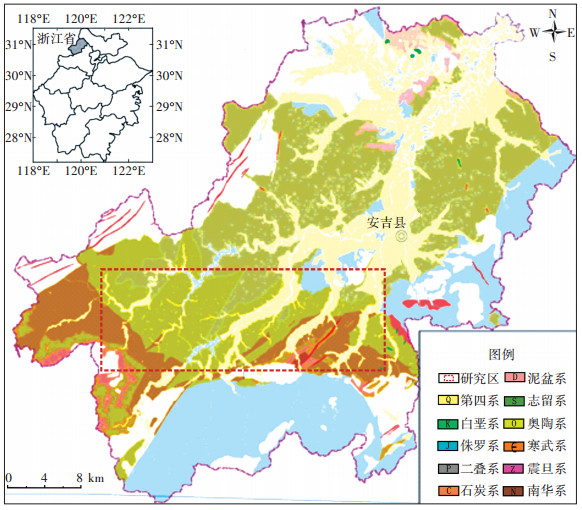
|
| 图 1 研究区地理位置及地层分布图(根据浙江省地质图修编) Figure 1 Geographic location and stratigraphic distribution of the study area(Modified from Geological map of Zhejiang Province, P.R.C.) |
表层土壤样品采集按照中国地质调查局实施的土地质量地球化学评价规范(DZ/T 0295-2016)技术要求执行, 采样密度为4件·km-2, 土壤采集3~5点的0~20 cm表层土壤混合组成一个点的土壤样。采样点一般布设于水田、旱田中, 采样时避开新搬运的堆积土和局部污染区。土壤样品凉干后过20目尼龙筛。同时采集研究区有代表性地层出露单元的基岩样品, 纯水冲洗干净, 晾干后粉碎并过200目筛。土壤和岩石样品测试均在安徽省地质实验研究所完成, 样品经HCl-HNO3-HClO4-HF等步骤消解后, 采用电感耦合等离子体质谱仪(ICP-MS)测定Cd、Cu、Pb、Zn、Cr、Ni等重金属元素含量; Hg、As、Se等经过王水消解后采用原子荧光光谱法(AFS)测定; 土壤pH采用酸度计测定。实验室采用国家标准物质和重复样测试进行质量监控, 各类指标分析的准确度(ΔlgC)控制在0.10~0.12, 精密度(RSD)控制在10%~20%, 报出率达到98%以上。
土壤重金属有效态采用CaCl2提取法, 具体步骤如下:称取2 g土壤(过2 mm筛)于50 mL离心管中; 加入20 mL 0.01 mol·L-1 CaCl2溶液, 在20℃环境中水平振荡2 h; 5000 r·min-1离心5 min, 0.45 μm滤膜过滤后得上清液待测。上清液中重金属元素(Cd、Zn、Se、Ni、As、Pb、Cu、Cr)含量采用ICP-MS进行测定。每个样品设置3个平行实验, 并通过加入标准土壤样品进行质量控制。
1.3 数据处理所有实验数据均采用SPSS 16.0和Excel 2016进行统计分析。图件处理采用CorelDRAW 12和Surfer 11进行图形处理。
2 结果与讨论 2.1 黑色页岩地球化学特征研究区奥陶系、寒武系地层(不包括荷塘组)和下寒武统(荷塘组)重金属的范围和平均含量见表 1。下寒武统(荷塘组)地层中明显富集Cd、Cr、Ni、Cu、Zn、As、Hg、Se。Cd和Se的浓度范围分别为6×10-8~ 104.48 mg·kg-1和0.11~43.49 mg·kg-1。奥陶系和寒武系地层中重金属元素的变异系数分布在13%~85%之间, 除寒武系地层中Cd、As、Hg、Se和奥陶系地层中Hg, 其他元素的变异系数(CV)均在13%~85%之间。在下寒武统(荷塘组)地层中, 除Cr、Cu、Pb、Se外, 其余元素的CV均大于100%, Mn、Ni、Zn、Cd、As、Hg的变异系数分别为241%、124%、167%、236%、110%和116%, 具有较高的CV值, 表明这些元素的含量均呈偏态分布。下寒武统(荷塘组)的重金属存在高含量的异常值, 因而具有较高的CV值。采用Turekian与Wedepohl等[17]页岩中相关元素的含量值作为世界页岩平均值(表 1), 研究区荷塘组的Cd、Cr、Ni、Cu、Zn、Pb、As、Hg、Se等元素平均值分别是世界页岩平均值的2.20、1.96、3.62、4.15、1.97、133.96、7.64、3.40倍和190.05倍。
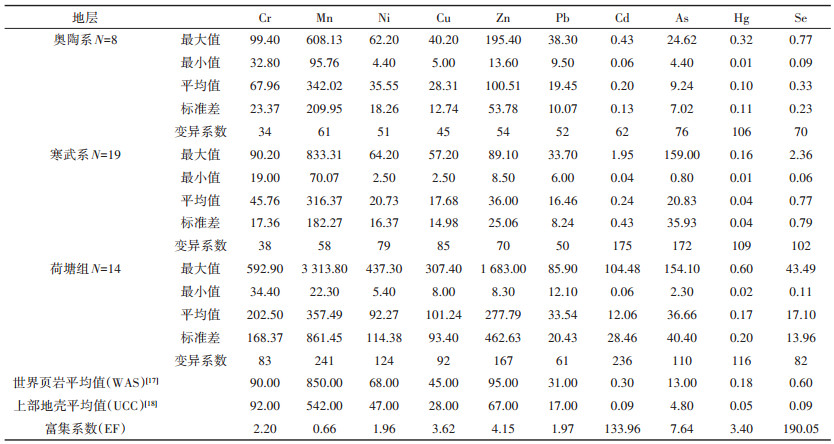
|
我国及世界广泛分布着黑色页岩, 表 2为我国湖南湘中和贵州遵义、韩国、美国等地黑色页岩中重金属元素含量值, 相对于上部地壳(UCC)和世界页岩(WAS)的水平, 黑色页岩中明显富集重金属元素, 尤其是Cd和Se, 研究区的含量明显高于我国和世界其他黑色页岩[19-24]。因此可以推断, 黑色页岩作为土壤发育所需的基岩决定了土壤中各种元素的初始含量, 同时, 黑色页岩在风化淋溶过程中, 产生的酸性排水导致当地土地酸化, 从而产生重金属的后期输入[24]。

|
研究区土壤重金属元素及其他指标的范围和平均含量见表 3, 土壤中Cu、Zn、Cd、Hg和Se的平均含量分别为33.31、113.04、0.81、0.12 mg·kg-1和0.68 mg· kg-1, 显著高于浙江省和中国其他土壤中这些元素的背景值[26-27]。而Cr和Ni的含量平均值略高于中国土壤背景值, 但低于浙江省土壤背景值。因此, 根据中国土壤环境质量标准(GB 15618-1995)重金属Ⅱ级标准, 研究区土壤样品中Cd (67.81%)、As (7.81%)、Cu (7.18%)、Zn(4.68%)、Hg(1.87%)等元素含量超标。Cd、As、Cu、Zn、Hg的CV较高, 分别为161.82%、104.22%、74.38%、47.81%和53.75%。与中国土壤背景值比较, Cd和Se的平均含量分别超过中国土壤背景值的8.35倍和2.35倍。因此, 在风险评价和环境修复中应重点关注研究区土壤中Cd的污染。

|
为了探讨研究区母岩岩石和土壤中重金属的地球化学特征, 确定了土壤和岩石中重金属含量的Pearson相关关系。岩石中的重金属元素含量的Pearson相关系数见表 4(A), 在P < 0.01水平下, Cr、Ni、Zn、Pb、Cd、As、Hg、Se与Cu呈极显著正相关, Hg、Se与Cr、Cd、Zn呈极显著正相关, Zn与Cd、Hg与Se呈极显著正相关; 在P < 0.05水平下, Cr与Pb、Ni与As呈显著相关关系。土壤中重金属元素的Pearson相关系数见表 4(B), 在P < 0.01水平下, 除Hg与Cr呈极显著正相关外, Hg仅与Pb有显著相关, 说明土壤中一部分Hg和Pb具有其他来源; 研究区土壤中超标的Cd和Se元素, 除与Hg与Se不相关, 在P < 0.01水平下, 与其他元素均呈现出极显著正相关。
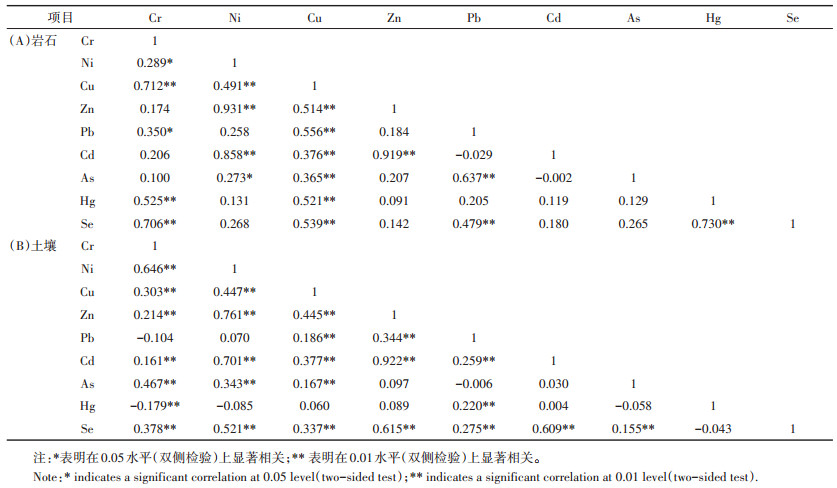
|
为了进一步分析土壤与母岩的重金属污染特征, 对各变量进行了主成分分析, 突出各元素在整个系统中的贡献, 进而识别其来源[28-31]。如表 5(A)所示, 旋转求解得到的主成分三个因子贡献了约84.32%的总重金属变量值:第一主成分因子PC1贡献约32.72%, 而Cd、Zn和Ni在PC1上有最高的得分; 第二主成分因子PC2贡献约30.96%, Cr、Cu、Hg和Se在PC2上有最高的得分; 第三主成分因子PC3贡献约20.64%, As和Pb在PC3上有最高的得分。在图 2(A)中可以看出, 在PC1和PC2中具有较高得分的元素成分基本一致, 说明它们具有同源性, 同时Pearson相关分析也可以推导这些元素间具极显著的相关关系。
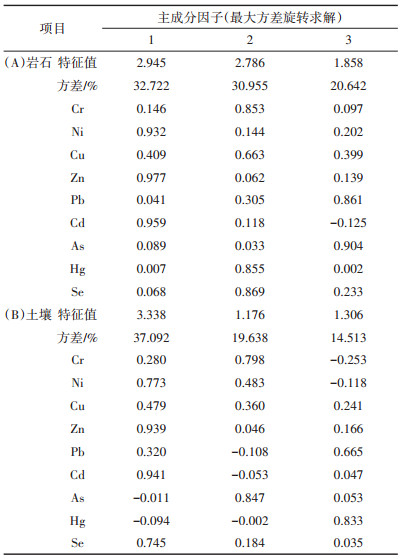
|
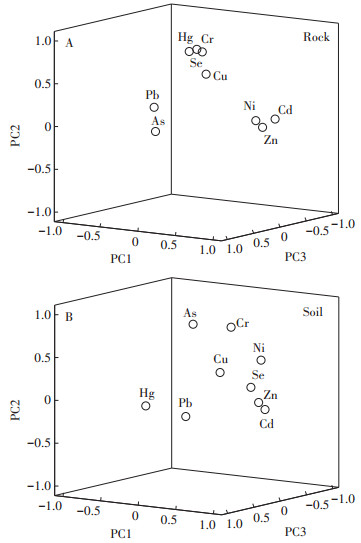
|
| 图 2 岩石和土壤中重金属的主成分空间分布图 Figure 2 Spatial distribution plots of heavy metals in rocks and soils by principal components analysis |
土壤样品(表 5B)旋转求解的三个主成分因子解释了约71.24%的变量, 其中第一主成分因子PC1解释了约37.09%的整体变量, Cd、Zn、Ni和Se在PC1上得分最高, Cr和As在PC2上有最高的得分, PC2解释约19.64%的整体变量, 第三主成分因子PC3中Pb和Hg得分最高, 解释约14.51%的整体变量。同样在PCA空间分布上图 2(B)上也印证了Pearson相关分析。因此, 从母岩和土壤的主成分和相关分析结果可看出, 重金素元素在母岩和土壤中具有同源性。
重金属防治和治理的关键是阐明重金属在土壤中赋存状态以及重金属污染元素的迁移能力。由黑色页岩自然风化而来的土壤因继承了母质的特征而富集重金属, 但土壤中重金属元素含量比值大小存在着差异, 指示了不同重金属元素在风化成土过程中的迁移能力的活动性强弱。黑色页岩形成于停滞还原水环境, 在缺氧的环境下, Zn、Cd、Ni、Cu在沉积过程中具有相似地球化学行为和相对稳定的比值已得到证实[8, 31-32]。从研究区土壤和岩石中Zn/Cd、Ni/Cu的比值关系(图 3)可以看出, 这两对的比值相关系数分别为0.698 7和0.305 6, 较高的相关系数说明这些元素之间具有相同的来源和相似的地球化学行为。Zn、Cd、Ni、Cu具有相同的来源和相似的地球化学行为, 在成土过程中这些性质和迁移行为相似的元素可能同时发生淋溶迁出母质岩石, 因此在土壤中的地球化学行为继承了在岩石和母质中的特征。

|
| 图 3 土壤及黑色页岩重金属元素Zn对Cd、Ni对Cu相关图 Figure 3 Plots of heavy metal Zn vs Cd and Ni vs Cu in soils and the corresponding black shales |
根据土壤中重金属元素含量绘制的土壤重金属分布图(图 4), 可用于重金属元素富集区的识别, 结合研究区黑色页岩的地层分布图(图 1), 可以确定, 土壤中重金属高含量分布区与黑色页岩地层的出露具有明显的对应关系, 证实了研究区土壤重金属元素来源于成壤母质黑色页岩。黑色页岩地层发育区内的土壤中Cd、Zn、Cu和Ni的含量均超过了土壤环境质量标准二级土壤限制值。最高含量的元素Cd达到了13.03 mg·kg-1, 超出标准的43倍。出现在黑色页岩发育区东部区域的Cu含量高异常值, 通过调查其位于村庄附近工厂, 因此该异常属于人为活动引起。从土壤重金属分布图可看出, Cd、Se、Zn、Cu和Ni的异常高值区空间分布与寒武系黑色页岩地层分布区具有一致性。而在整个研究区域内As、Hg和Pb的分布相对比较均一, 出现的高异常区域均不位于黑色页岩地层岩石发育区, 验证了黑色页岩不是这几种元素的来源, 可能具有其他来源, 同时验证了土壤中Cd、Se、Zn、Cu和Ni元素来源于黑色页岩地层。
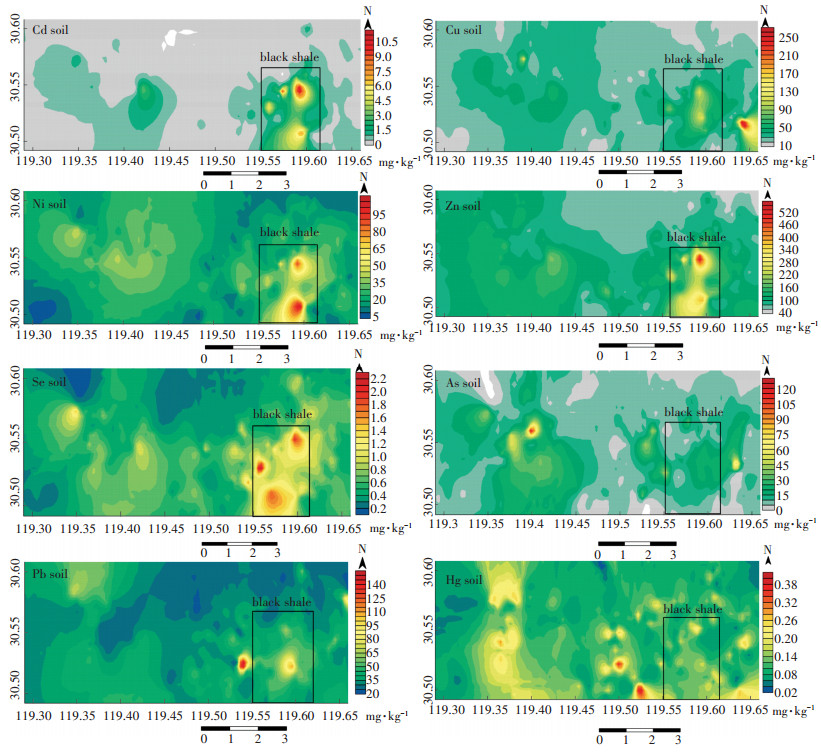
|
| 图 4 土壤中重金属空间分布含量图 Figure 4 Spatial distribution maps of heavy metals in soils |
土壤重金属的生物有效性取决于其存在形态及其成因来源。土壤重金属含量虽能反映重金属的富集程度, 而重金属的生物有效态量能反映在生物可利用性和生物毒性上[33]。土壤元素生物可利用率是指实验测得的土壤元素生物有效态量与总量的比值, 即生物有效性(%)=(土壤元素有效态量/土壤元素总量) ×100%。CaCl2提取的重金属含量可指示该重金属在土壤微生物及植物根系中的生物有效性, 能更好地评价重金属的毒性[34]。因此, 本研究以CaCl2提取土壤重金属的方法为基础, 来判别研究区土壤重金属的生物有效性及其影响因素, 土壤重金属潜在生物可利用率变化范围及平均值如表 6所示。总体上, 重金属有效态的含量和生物可利用率差异较大。研究区土壤中重金属有效态含量顺序为Zn>Ni>Cd>Cu>Pb> As>Cr>Se, 生物可利用率顺序为Cd>Zn>Se>Ni>As> Pb>Cu>Cr。

|
研究表明, 土壤中的金属元素生物有效性受到土壤酸碱性、阳离子交换量、氧化还原电位、有机质含量、质地、黏土矿物等因素的影响, 同时也受到元素自身地球化学行为和其他元素浓度的影响和控制, 关键因素是土壤中金属元素的解吸和吸附过程控制的土壤金属活动性大小[35-37]。表 7为土壤重金属生物有效可利用率与土壤性质和重金属含量间的相关系数, 生物利用率相对高的元素Cd、Zn、Se和Ni与土壤重金属含量无关。土壤中含量高的元素中仅Se与S和CaO在P < 0.01的水平上呈正相关; 与SiO2在P < 0.05的水平上呈负相关。Cd和Ni在P < 0.05的水平上与CaO和MgO呈负相关, 与SiO2呈正相关。土壤中的常量元素氧化物是土壤矿物和黏粒的重要组成部分, 黏土矿物对重金属离子具有强吸附性, 从而影响生物对重金属元素有效性[38-39]。土壤中pH与CEC和Cd、Zn、Se和Ni等元素在P < 0.01水平上呈显著正相关。土壤较高有机质和CEC可使土壤对Cd的吸附和保持能力增强[39]。研究区土壤中的有机质与重金属生物利用率无相关性。土壤中有机质组成极为复杂[33], 从而影响土壤重金属生物利用率。从重金属来源分析看, 研究区高生物可利用率元素Cd、Zn、Se和Ni均来自于黑色页岩地层岩石风化。已有研究表明, 人为活动影响下的重金属污染土壤的重金属生物可利用率高于地质高背景来源重金属[40-42]。而在研究区未知来源的As和Pb来源未确定, 而研究区地质背景较为复杂, 其低的生物可利用率和来源有待于进一步探讨。
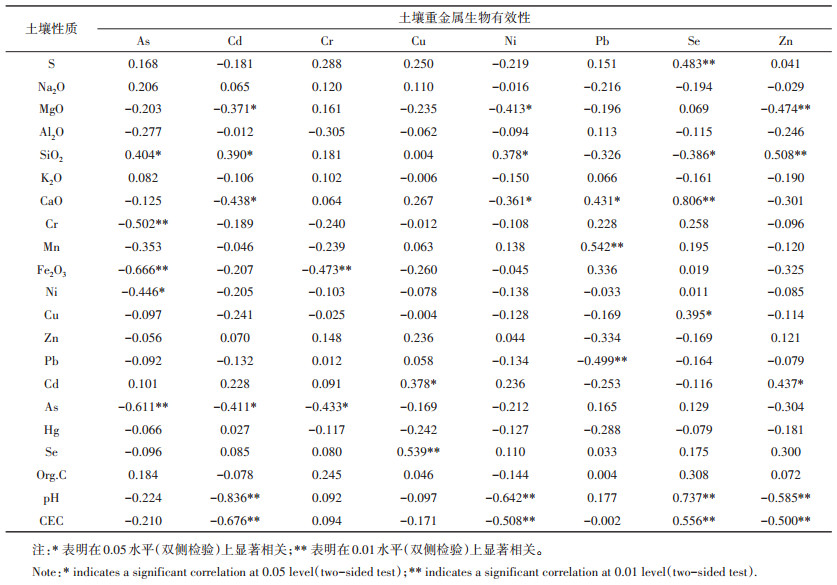
|
(1) 研究区主要出露地层中, 下寒武统(荷塘组)地层的黑色页岩中明显富集Cr、Ni、Cu、Zn、Pb、Cd、As、Hg和Se等重金属元素, 通过对比发现Cd和Se元素比世界其他区域页岩平均值分别高134倍和190倍。
(2) 研究区由黑色页岩区域发育而来的土壤中Cd、As、Cu、Zn和Hg存在不同程度的超标现象。根据中国土壤环境质量标准(GB15618-1995), 这5种元素的污染程度大小顺序为Cd(67.81%) >As(7.81%) > Cu (7.18%) >Zn (4.68%) >Hg (1.87%)。
(3) 土壤中Cd、Cu、Se、Ni、Zn空间分布和来源分析与黑色页岩出露区域一致, 因此, 其主要来源为黑色页岩风化, 但土壤中As、Hg和Pb在研究区分布较为均一, 可能存在着其他来源。
(4) 研究区土壤重金属生物有效性和生物可利用率主要受来源控制, 土壤中Cd元素的生物可利用率相对其他元素最强, 其主控因素为土壤pH和CEC。
| [1] |
He B, Yun Z J, Shi J B, et al. Research progress of heavy metal pollution in China:sources, analytical methods, status, and toxicity[J]. Chinese Science Bulletin, 2013, 58(2): 134-140. DOI:10.1007/s11434-012-5541-0 |
| [2] |
Lv J S, Liu Y, Zhang Z L, et al. Factorial kriging and stepwise regression approach to identify environmental factors influencing spatial multi-scale variability of heavy metals in soils[J]. Journal of Hazardous Materials, 2013, 261: 387-397. DOI:10.1016/j.jhazmat.2013.07.065 |
| [3] |
Nanos N, Rodríguez Martín J A. Multiscale analysis of heavy metal content in soils:spatial variability in the Duero river basin(Spain)[J]. Geoderma, 2012, 189: 554-562. |
| [4] |
唐晓燕, 彭渤, 余昌训, 等. 湘中安化下寒武统黑色页岩土壤元素地球化学特征[J]. 环境科学学报, 2009, 29(12): 2623-2634. TANG Xiao-yan, PENG Bo, YU Chang-xun, et al. Elemental geochemistry of soils derved from the Lower-Cambrian black shales in Anhua county, central Hunan(China)[J]. Acta Scientiae Circumstantiae, 2009, 29(12): 2623-2634. |
| [5] |
Xu J Z, Peng B, Yu C X, et al. Geochemistry of soils derived black shales in the Ganziping mine area, western Hunan, China[J]. Environmental Earth Sciences, 2013, 70(1): 175-190. DOI:10.1007/s12665-012-2114-0 |
| [6] |
Peng B, Rate A, Song Z L, et al. Geochemistry of major and trace elements and Pb-Sr isotopes of a weathering profile developed on the Lower Cambrian black shales in central Hunan, China[J]. Applied Geochemistry, 2014, 51: 191-203. DOI:10.1016/j.apgeochem.2014.09.007 |
| [7] |
Yu C X, Lavergren U, Peltola P, et al. Retention and transport of arsenic, uranium and nickel in a black shale setting revealed by a longterm humidity cell test and sequential chemical extractions[J]. Chemical Geology, 2014, 363: 134-144. DOI:10.1016/j.chemgeo.2013.11.003 |
| [8] |
Liu Y, Xiao T, Perkins R B, et al. Geogenic cadmium pollution and potential health risks, with emphasis on black shale[J]. Journal of Geochemical Exploration, 2017, 176: 42-49. DOI:10.1016/j.gexplo.2016.04.004 |
| [9] |
Lavergren U, Åström M E, Falk H, et al. Metal dispersion in groundwater in an area with natural and processed black shale:Nationwide perspective and comparison with acid sulfate soils[J]. Applied Geochemistry, 2009, 24: 359-369. DOI:10.1016/j.apgeochem.2008.11.022 |
| [10] |
Perkins R B, Mason C E. The relative mobility of trace elements from short-term weathering of a black shale[J]. Applied Geochemistry, 2015, 56: 67-79. DOI:10.1016/j.apgeochem.2015.01.014 |
| [11] |
Yu C X, Peng B, Peltola P, et al. Effect of weathering on abundance and release of potentially toxic elements in soils developed on Lower Cambrian black shales, P. R. China[J]. Environmental Geochemisty and Health, 2012, 34: 375-390. DOI:10.1007/s10653-011-9398-y |
| [12] |
杨恩林, 吕新彪, 鲍淼, 等. 黔东下寒武统黑色页岩微量元素的富集及成因分析[J]. 地球科学进展, 2013, 28(10): 1160-1169. YANG En-lin, LÜ Xin-biao, BAO Miao, et al. Enrichment and origin of some trace elements in black shales from the early Cambrian in eastern Guizhou Province[J]. Advances in Earth Science, 2013, 28(10): 1160-1169. DOI:10.11867/j.issn.1001-8166.2013.10.1160 |
| [13] |
杨克苏, 彭渤, 刘茜, 等. 湘中安化黑色页岩土壤玉米的元素地球化学分析[J]. 矿物岩石地球化学学报, 2012, 31(3): 236-248. YANG Ke-su, PENG Bo, LIU Qian, et al. Elemental geochemistry of maize grown on the black shale soil in Anhua county, central Hunan, China[J]. Bulletin of Mineralogy, Petrology and Geochemistry, 2012, 31(3): 236-248. |
| [14] |
谢淑容, 彭渤, 唐晓燕, 等. 湘中地区发育于黑色页岩上土壤重金属污染特征[J]. 土壤通报, 2008, 39(1): 137-142. XIE Shu-rong, PENG Bo, TANG Xiao-yan, et al. Characteristics of heavy metal contamination of soils derived from black shale in the contral Hunan, China[J]. Chinese Journal of Soil Science, 2008, 39(1): 137-142. |
| [15] |
钱建民, 刘崇民, 杜红东, 等. 浙江省下寒武统荷塘组黑色页岩系地球化学特征[J]. 物探与化探, 2009, 33(4): 395-399. QIAN Jian-min, LIU Chong-min, DU Hong-dong, et al. Geochemical characteristics Black shales in lower Cambrian HETANG formation, Zhejiang Province[J]. Geophysical and Geochemical Exploration, 2009, 33(4): 395-399. |
| [16] |
宋明义. 浙西地区下寒武统黑色页岩系中硒与重金属的表生地球化学及环境效应[D]. 合肥: 合肥工业大学, 2009. SONG Ming-yi. Supergenic geochemistry and environmental effects of selenium and heavy metals in the lower Cambrian Black series of Western Zhejiang Province, China[D]. Heifei: Heifei University of Technology, 2009. |
| [17] |
Turekian K K, Wedepohl K H. Distribution of the elements in some major units of the Earth's crust[J]. Geological Society of America Bulletin, 1961, 72: 175-191. DOI:10.1130/0016-7606(1961)72[175:DOTEIS]2.0.CO;2 |
| [18] |
Rudnick R L, Gao S. 3. 01-Composition of the continental crust[M]//Turekian K K(Ed. ). Treatise on Geochemistry. Oxford: Pergamon, 2003: 1-64.
|
| [19] |
Lavergren U, Åström M E, Bergbäck B, et al. Mobility of trace elements in black shale assessed by leaching tests and sequential chemical extraction[J]. Geochemistry:Exploration, Environment, Analysis, 2009, 9(1): 71-79. DOI:10.1144/1467-7873/08-188 |
| [20] |
Tuttle M L W, Breit G N, Goldhaber M B. Weathering of the New Albany Shale, Kentucky:Ⅱ. Redistribution of minor and trace elements[J]. Applied Geochemistry, 2009, 24: 1565-1578. DOI:10.1016/j.apgeochem.2009.04.034 |
| [21] |
Perkins R B, Piper D Z, Mason C E. Trace-element budgets in the Ohio/Sunbury Shales of Kentucky:constraints on ocean circulation and primary productivity in the Devonian-Mississippian Appalachian Basin[J]. Palaeogeography, Palaeoclimatology, Palaeoecology, 2008, 265: 14-29. DOI:10.1016/j.palaeo.2008.04.012 |
| [22] |
Rimmer S M. Geochemical paleoredox indicators in Devonian-Mississippian black shales, Central Appalachian Basin(USA)[J]. Chemical Geology, 2004, 206: 373-391. DOI:10.1016/j.chemgeo.2003.12.029 |
| [23] |
Lee J S, Chon H T, Kim K W, et al. Enrichment of potentially toxic elements in areas underlain by black shales and slates in Korea[J]. Environmental Geochemistry and Health, 1998, 20: 135-147. DOI:10.1023/A:1006571223295 |
| [24] |
Pašava J, Kríbek B, Žák K, et al. Preliminary results of the study of toxic elements in soils and crop plants in areas of Ni-Mo blackshalehosted deposits(Zunyi region, south China)[C]. Seventh Biennial SGA Meeting, Athens/Greece, Vol. 1 Aug 24-28, 2003. https://www.researchgate.net/publication/285840231_Preliminary_results_of_the_study_of_toxic_elements_in_soils_and_crop_plants_in_areas_of_Ni-Mo_black_shale-hosted_deposits_Zunyi_region_south_China
|
| [25] |
余昌训, 彭渤, 唐晓燕, 等. 湘中下寒武统黑色页岩土壤的地球化学特征[J]. 土壤学报, 2009, 46(4): 557-570. YU Chang-xun, PENG Bo, TANG Xiao-yan, et al. Geochemical characteristics of soils derived from the lower-Cambrian black shales distributed in central Hunan China[J]. Acta Pedologica Sinica, 2009, 46(4): 557-570. DOI:10.11766/trxb200810110401 |
| [26] |
董岩翔, 郑文, 周建华, 等. 浙江省土壤地球化学背景值[M]. 北京: 中国地质出版社, 2007.
|
| [27] |
国家环境保护局. 中国土壤元素背景值[M]. 北京: 中国环境科学出版社, 1990. EMSC(Environment Monitoring Station of China). Background values of soil elements in China[M]. Beijing: China Environmental Science Press, 1990. |
| [28] |
Huang S, Tu J, Liu H, et al. Multivariate analysis of trace element concentrations in atmospheric deposition in the Yangtze River Delta, East China[J]. Atmospheric Environment, 2009, 43(36): 5781-5790. DOI:10.1016/j.atmosenv.2009.07.055 |
| [29] |
Quezada-Hinojosa R P, Föllmi K B, Verrecchia E, et al. Speciation and multivariable analyses of geogenic cadmium in soils at Le Gurnigel, Swiss Jura Mountains[J]. CATENA, 2015, 125: 10-32. DOI:10.1016/j.catena.2014.10.003 |
| [30] |
Quezada-Hinojosa R P, Matera V, Adatte T, et al. Cadmium distribution in soils covering Jurassic oolitic limestone with high Cd contents in the Swiss Jura[J]. Geoderma, 2009, 150: 287-301. DOI:10.1016/j.geoderma.2009.02.013 |
| [31] |
凌斯祥, 巫锡勇, 孙春卫, 等. 黑色页岩化学风化过程的微观机制及演化[J]. 成都理工大学学报(自然科学版), 2017, 44(2): 195-204. LING Si-xiang, WU Xi-yong, SUN Chun-wei, et al. Research on micro-mechanism and evolution of black shale in chemical weathering process[J]. Journal of Chengdu University of Technology(Science and Technology Edition), 2017, 44(2): 195-204. |
| [32] |
Piper D Z, Calvert S E. A marine biogeochemical perspective on black shale deposition[J]. Earth-Science Reviews, 2009, 95: 63-96. DOI:10.1016/j.earscirev.2009.03.001 |
| [33] |
周国华. 土壤重金属生物有效性研究进展[J]. 物探与化探, 2014, 38(6): 1097-1106. ZHOU Guo-hua. Recent progress in the study of heavy metal bioavailability[J]. Geophysical and Geochemical Exploration, 2014, 38(6): 1097-1106. DOI:10.11720/wtyht.2014.6.01 |
| [34] |
钱海燕, 王兴祥, 黄国勤, 等. 钙镁磷肥和石灰对受Cu、Zn污染的菜园土壤的改良作用[J]. 农业环境科学学报, 2007, 26(1): 235-239. QIAN Hai-yan, WANG Xing-xiang, HUANG Guo-qin, et al. Melioration effect of calcium magnesium phosphate and calcareousness on vegetable garden soil polluted by Cu and Zn[J]. Journal of Agro-Environmental Science, 2007, 26(1): 235-239. |
| [35] |
Alloway B J. Heavy metals in soils: trace metals and metalloids in soils and their bioavailability[M]. Third Edition. Springer, 2013: 351-373.
|
| [36] |
Sahuquillo A, Rigol A, Rauret G. Overview of the use of leaching/extraction tests for risk assessment of trace metals in contaminated soil and sediments[J]. TrAC Trends in Analytical Chemistry, 2003, 22(3): 152-159. DOI:10.1016/S0165-9936(03)00303-0 |
| [37] |
Guan D X, Williams P N, Xu H C, et al. High-resolution measurement and mapping of tungstate in waters, soils and sediments using the low-disturbance DGT sampling technique[J]. Journal of Hazardous Materials, 2016, 316: 69-76. DOI:10.1016/j.jhazmat.2016.05.026 |
| [38] |
胡省英, 冉伟彦, 范宏瑞. 土壤-作物系统中重金属元素的地球化学行为[J]. 地质与勘探, 2003, 39(5): 84-87. HU Sheng-ying, RAN Wei-yan, FAN Hong-rui. Geochemical behavior of heavy metal elements in soil-crop system[J]. Geology and Prospecting, 2003, 39(5): 84-87. |
| [39] |
Kabata-Pendias A. Trace elements in soils and plants[M]. fourth Edition. , CRC Press, 2011.
|
| [40] |
何腾兵, 董玲玲, 李广枝, 等. 喀斯特山区不同母质(岩)发育的土壤主要重金属含量差异性研究[J]. 农业环境科学学报, 2008, 27(1): 188-193. HE Teng-bing, DONG Ling-ling, LI Guang-zhi, et al. Differences of heavy metal contents in soils derived from different parent materials rocks in karst mountain area[J]. Journal of Agro-Environment Science, 2008, 27(1): 188-193. |
| [41] |
唐豆豆, 袁旭音, 汪宜敏, 等. 地质高背景农田土壤中水稻对重金属的富集特征及风险预测[J]. 农业环境科学学报, 2018, 37(1): 18-26. TANG Dou-dou, YUAN Xu-yin, WANG Yi-min, et al. Enrichment characteristics and risk prediction of heavy metals for rice grains growing in paddy soils with a high geological background[J]. Journal of Agro-Environment Science, 2018, 37(1): 18-26. DOI:10.11654/jaes.2017-0801 |
| [42] |
张风雷, 郑循艺, 陈琦伟, 等. 重金属地质高背景区及工业园区农作物重金属健康风险评价:以重庆市梁平区现代农业示范区为例[J]. 地球与环境, 2017, 45(5): 567-575. ZHANG Feng-lei, ZHENG Xun-yi, CHEN Qi-wei, et al. Health risk assessment of heavy metals in crops from geological Background of high heavy metals and industrial suburb:Taking of modern agricultural demonstration zone of Liangping country as an example[J]. Earth and Environment, 2017, 45(5): 567-575. |
 2018, Vol. 37
2018, Vol. 37



